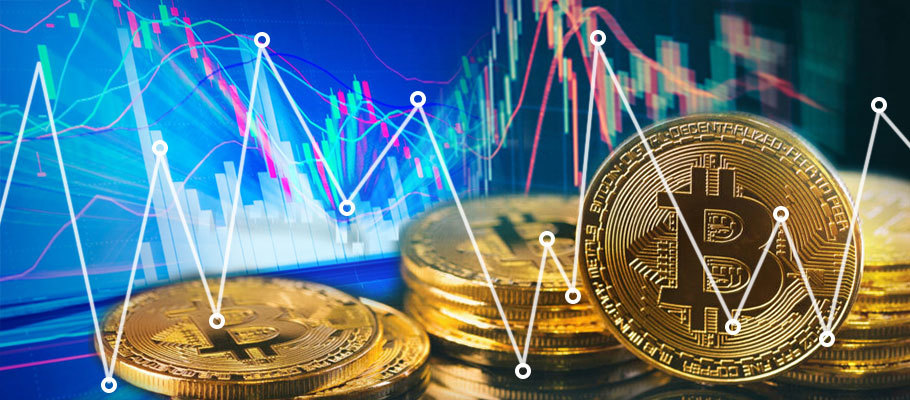
Published: March 12th, 2021
Crypto markets have been on full boil over the last fortnight. At mid-week global market capitalisation had added 6 per cent to gains posted on Monday to hit USD 1.72 trillion, but within a few hours, it had fallen back to USD 1.67 trillion.
That was the steepest fall posted in March and had some analysts drawing comparisons to the massive plunge in Bitcoin and Ethereum prices seen on 23rd February. At the time of writing, however, crypto markets look to be buoyant again. So what's going on?
Bitcoin is currently subject to price swings in the 5 per cent range after a year in which swings of 2 per cent were the norm. Action on exchanges has been a significant factor in this. Numbers from on-chain analytics firm CryptoQuant show that supplies of BTC held on exchanges has dropped to two-year lows.
That points to a lot of money shifting into some form of cold storage, reducing supply and subsequently adding to price pressure as access to Bitcoin is restricted.
While that’s been happening, Wall Street bankers JP Morgan signalled a move into crypto when it made an application to the US Securities and Exchange Commission (SEC) to launch a ‘cryptocurrency exposure basket.’ The idea is that investors could gain indirect exposure to BTC through companies like Square and MicroStrategy that already have significant crypto positions.
On the macroeconomic front, the Biden administration’s passing of a USD 1.9 trillion stimulus package looks to be adding wind to the market’s sails.
Analysts at crypto financial-services firm Amber Group told Bloomberg this week that interest levels in crypto from institutional players have been on the rise globally. They said high-net-worth investors in China have been making more inquiries about how to add BTC to their portfolios.
That all helps explain the upward pressure on crypto prices, but there have also been bear-ish headwinds across the global economy, pushing back and unsettling price action.
The sale this week of USD 37 billion in US government bonds is being watched closely by investors for signals of what’s likely to come for the US and global economies.
Sales were tepid when Washington tried to auction off bonds last month in a bid to pay down some of the country’s estimated USD 21 trillion in debt. The chilly market response sent a wave of uncertainty across global markets since American government debt is used by lenders as a risk benchmark underpinning everything from credit cards to mortgages. Crypto prices fell as a result.
Why would that influence investors with short-term investment objectives? If a state bond sale flops, the issuing government will need to raise interest rates on the debt to make the offer more attractive. That creates tension between Washington’s ability to raise money through debt issues and investors who typically buy them.
Back in the ‘80s, a group of investors dubbed the ‘bond vigilantes’ held the US government’s feet to the fire on economic policy by refusing to purchase bonds. The new 1.9 trillion stimulus bill will be contentious for some investors as the printing of new money could push up inflation and raise interest rates. Many companies want to avoid the latter as low prices and low-interest rates have enabled them to spend and borrow their way through the pandemic.
Interest rates in particular seem to have investors worried. Several different business surveys undertaken by the US Federal Reserve in recent weeks have shown that businesses are now paying the highest prices in a decade for raw materials, with commodities like copper shooting up more rapidly than they did in the 2008/2009 financial crisis.
The rising cost of doing business in America will be interpreted by some as a worrying indication that the US economy has started overheating. Some of that concern is borne out by irrational stock market trends, especially in the bubbling Nasdaq exchange, heavily weighted to technology stocks.
Numbers from crypto market analytics firm Nomics shows crypto's big caps, Bitcoin and Ethereum, have been in a pattern of swings and roundabouts for the last two weeks. Bitcoin reached heights as high as USD 55,471 before sliding back to USD 53,100; all in about three hours.
The price of Ethereum bounced along on a similar see-saw pattern, climbing to USD 1,857 and close to touching its previous all-time high of USD 1,958 reached during February’s raging crypto bull run. But it also fell back to Earth shortly after, returning to the USD 1,700 range. As of Friday, it looked to be making gains again.
Does more volatility lie ahead? On Thursday, US president Joe Biden signed his ambitious American Rescue Plan legislation into law. It will pump USD 2 trillion of stimulus into the US economy, much of it targeted to reach ordinary Americans following the business- and investor-focused stimuli packages favoured by the previous Trump administration.
Biden’s pandemic recovery bill represents one of the biggest US government interventions into the domestic economy since the Second World War. It’s slightly less ambitious in scale than the USD 2.2 trillion package of March 2020, representing Washington's first major economic response to the pandemic.
It's significantly more, however than the USD 780 billion in support offered up in the wake of the 2008 financial crisis. Much of that went to shore-up banks and other financial institutions with the understanding that the benefits would be passed on to households and mortgage holders. Despite promises to the contrary, very little of that stimulus package actually reached ordinary consumers directly, causing much voter frustration and arguably setting the stage for a wave of US populism that swept the insurgent Trump administration into power.